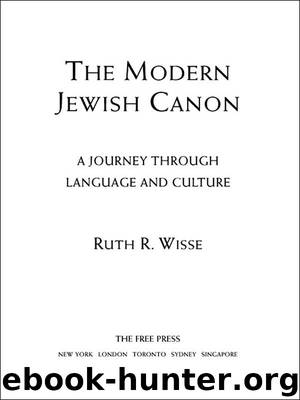THE MODERN JEWISH CANON by RUTH R. WISSE

Author:RUTH R. WISSE
Language: eng
Format: epub
Tags: Literature
Publisher: THE FREE PRESS
Published: 2000-11-01T00:00:00+00:00
The Yiddish and Hebrew Diarists
Yiddish was the European language most directly affected by Nazi rule. Although linguistic assimilation had become the norm by the 1930s among Jews in western Europe, the Soviet Union, and the United States, it was slowed in Poland by some of the external and internal forces of exclusion and renaissance alluded to in the previous chapters. Thus, Yiddish was the main language of the ghettos, and of the majority of Jews targeted for annihilation, though most Jews also knew at least one coterritorial language. When a lending library was established in the Vilna ghetto, it was announced after the one hundred thousandth book had been borrowed that 17.6 percent of this total were in Yiddish, 2 percent in Hebrew, 70.4 percent in Polish, and the rest in Russian and other languages. 25 That hundreds of Jews managed to pass for Poles on the Aryan side of the ghetto wall despite a veritable army of bounty hunters trying to detect them proves the high degree of acculturation indicated by the above statistics. At the same time, the widespread translation of literary works into Yiddish and Hebrew during the interwar period demonstrates not merely the avidity of the Jews for foreign cultures but their faith in the development of their own. In the Vilna ghetto, Yitskhok Rudashevski and his school chums drew their models of resistance from Der giber in keytn [The Hero in Chains], a shortened translation of Victor Hugo’s Les Miserables.
Vilna—“the mecca of Jewish nationalism in the interwar period” 26 or, as Jews typically referred to it, “the Jerusalem of Lithuania”—is an apt example of Jewish cultural autonomy during the period of World War II. Here, a generation of Western-trained scholars had founded their own quasi university in 1925, the YIVO Institute of Jewish Research, and here the Jewish Teachers’ Seminary trained pedagogues for its network of secular Jewish schools. Modern and traditional Jews benefited from common Jewish medical, social, and philanthropic institutions and studied side by side in the famed Strashun Library. Writers, poets, artists, actors, and journalists maintained a competitive press and theater. When the Germans occupied Warsaw in September 1939, thousands of Jewish refugees fled to Russian-occupied Vilna, further swelling the ranks of the local intellectual community and reinforcing the hope that communal discipline could be maintained within hostile surroundings. In trying to comprehend and respond to the shift of power around them, the Jews of Vilna drew upon a long history of cultural resistance to physical might.
The Germans began mass executions immediately after they took Vilna on June 24, 1941, and forced the remaining Jews into adjoining ghettos at the beginning of September. Mark Dworzecki, a physician and wartime diarist, reports that during the first hours of confinement, everyone had the same thought: “We have to write memoirs; each of us has to record what he sees, so that future generations should know it.” 27 This idea had already taken hold of Herman Kruk at the outbreak of the war two years earlier, when he fled his home in Warsaw in order to reach the Russian zone.
Download
This site does not store any files on its server. We only index and link to content provided by other sites. Please contact the content providers to delete copyright contents if any and email us, we'll remove relevant links or contents immediately.
| African | Asian |
| Australian & Oceanian | Canadian |
| Caribbean & Latin American | European |
| Jewish | Middle Eastern |
| Russian | United States |
4 3 2 1: A Novel by Paul Auster(11036)
The handmaid's tale by Margaret Atwood(6839)
Giovanni's Room by James Baldwin(5873)
Big Magic: Creative Living Beyond Fear by Elizabeth Gilbert(4719)
Asking the Right Questions: A Guide to Critical Thinking by M. Neil Browne & Stuart M. Keeley(4567)
On Writing A Memoir of the Craft by Stephen King(4206)
Ego Is the Enemy by Ryan Holiday(3983)
Ken Follett - World without end by Ken Follett(3968)
The Body: A Guide for Occupants by Bill Bryson(3791)
Bluets by Maggie Nelson(3705)
Adulting by Kelly Williams Brown(3663)
Guilty Pleasures by Laurell K Hamilton(3578)
Eat That Frog! by Brian Tracy(3509)
White Noise - A Novel by Don DeLillo(3430)
The Poetry of Pablo Neruda by Pablo Neruda(3358)
Alive: The Story of the Andes Survivors by Piers Paul Read(3304)
The Bookshop by Penelope Fitzgerald(3222)
The Book of Joy by Dalai Lama(3212)
Fingerprints of the Gods by Graham Hancock(3207)
